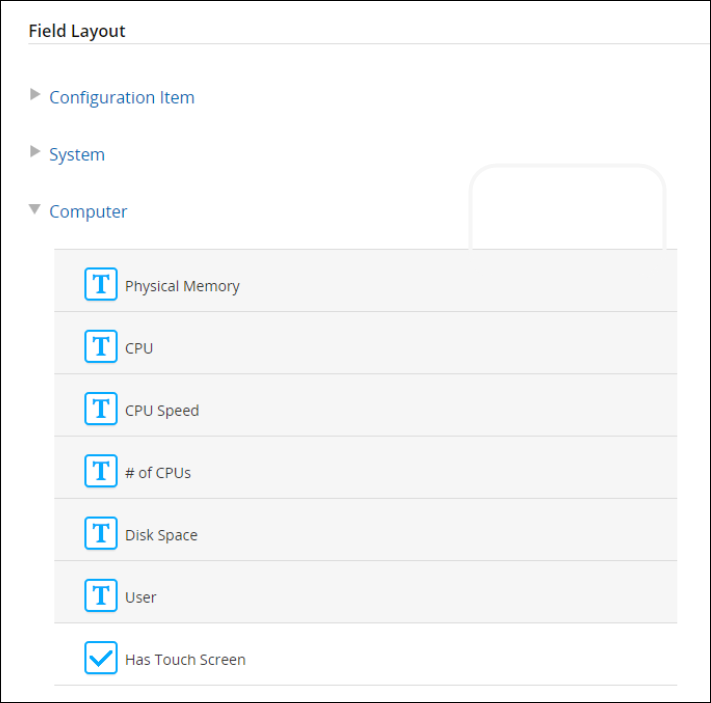Configuration item (CI) types
On this page
Introduction
The Service Desk CMDB data model has a parent/child hierarchy and provides out-of-the-box CIs. You can also create additional custom CI types to ensure your data model accurately reflects your physical and virtual IT infrastructure. You first define your CIs, then use the Service Desk CMDB data model to assist you in defining the relationships and dependencies of your CIs.
The CMDB data model is built so that each CI type inherits the layout and fields of its parent CI type. This allows for time efficient customization of the data model to meet each organization's business needs. For example, when you add a custom field to the System CI type layout, that field will display on all of its child layouts as well, such as computer, network device, and router.
Navigation
Setup > CMDB > CI Types.
List of CI types
The list below contains the common components used across most organizations.
| CI Type Name | Parent CI Type |
| Configuration Item | |
| Application | Configuration Item |
| Building | Configuration Item |
| Contract | Configuration Item |
| Data Center | Configuration Item |
| Database | Configuration Item |
| Group | Configuration Item |
| Legacy | Configuration Item |
| Other Asset | Configuration Item |
| Person | Configuration Item |
| Service | Configuration Item |
| Software | Configuration Item |
| System | Configuration Item |
| Vendor | Configuration Item |
View CI types
Navigate to Setup > CMDB > CI Types. The Configuration Item Types index page displays. (For more information on index pages, see List view.)
Your Custom CI types are stored in Legacy.
You can also see CI hierarchy on this page. CIs types with a chevron to the left have at least one child CI type. Click on the CI type to expand the list of child CI types.

Create a new CI type
-
Navigate to Setup > CMDB > CI Types.
-
Hover over the appropriate parent CI type until you see three buttons.
-
If you are adding a new CI type at the parent level, hover over Configuration Item.

-
If you are adding a new service, hover over Service to add a child.

-
-
Click Add
 .
. -
Name the new CI type, add an optional description, select Enabled, and then click Next. Service Desk creates the new CI type and adds it to the bottom of the list.
Edit an existing CI type
Hover over the CI type and click Edit ![]() . In the open CI type, any fields with a grey background are out-of-the-box and cannot be altered. Custom fields that you created contain a white background and can be modified to meet your needs.
. In the open CI type, any fields with a grey background are out-of-the-box and cannot be altered. Custom fields that you created contain a white background and can be modified to meet your needs.
You can then:
-
Edit the name and description of your CI type
-
Add custom fields
- Edit the CI type layout by hovering over the CI type and selecting the appropriate icon:
Add a custom field via drag-and-drop from the custom fields pane on the right.
- Remove custom fields via the trash icon.
Change custom fields to be mandatory or optional.
Move a custom field directly from the layout to another CI type.

- The layout editor shows you all layouts the current CI type inherits from the hierarchy.
- Only the current layout can be edited. For example, when editing the Network Device CI type, you will not be able to simultaneously edit the System CI type section.
- You can only move fields to a CI type if that CI type (1) inherits the field from a parent type or (2) does not already contain the field in its layout.
Disable, move, and/or remove a CI type and its branch
There are additional actions you can take to customize your CMDB by hovering over a CI type.

You can adjust the data model to meet your needs. If you currently don't want a specific device type, you can disable that type until the time that you need it.
- Disable. Disable a specific CI type and prevent users from creating instances of that type.
-
Disable all. Disable a CI type and all of its child types and prevent users from creating instances of these types.
Out-of-the-box CI types cannot be moved or removed; however, there are additional options for custom CI types you created.

For example:
-
Remove. Delete a CI type from the hierarchy.
This action cannot be undone. If data is associated with the CI type you wish to delete, you will be prompted to first delete the data. You can only delete a CI type if associated data has been deleted. - Move. Move a CI type and its children across the hierarchy. In order to move a CI type, you will be prompted to select a new parent.
- When moving a CI type in the hierarchy, the CI type will inherit its layout from the new parent. For example, if you move the CI type computer from System to Other Asset, the data will be maintained but the custom fields specific to the System hierarchy will no longer be reflected. Therefore, you must manually move any additional fields.
- Moving CI types across the hierarchy does not delete any field.
